When you fire up the Chrome browser on your Windows 11 or Windows 10 PC, you may notice the Paused text shown next to your profile icon which indicates your data is not synced across devices. This post offers working fixes you can easily apply to resolve the Sync Paused issue in Chrome.
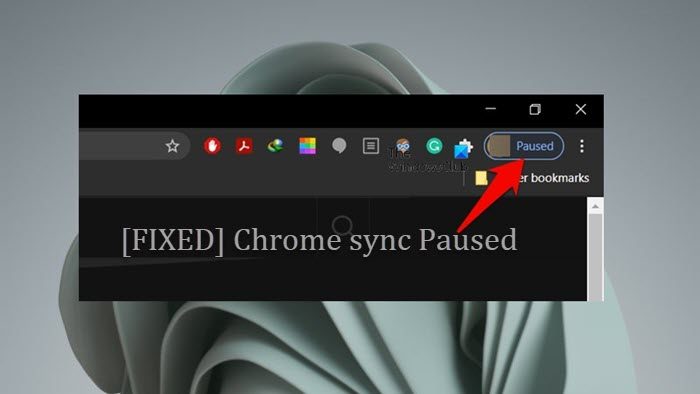
This issue is likely to occur due to several reasons, but it generally has to do with misconfigured Chrome or Google account settings. Also, if there is no data being stored as cookies, Chrome may automatically disable syncing and you will see the Signed out – syncing is paused message for your Google account.
Where are Google sync settings?
To turn on sync, you must have a Google Account and then proceed as follows:
- On your Android device, open the Chrome app. If you don’t yet have the Google Chrome app, download it from Google Play.
- On the right of the address bar, tap More Settings > Turn on sync.
- Choose the account that you want to use.
- Tap Yes, I’m in.
Fix sync Paused issue in Chrome
Suppose you see the Paused text in Chrome browser as shown in the lead-in image above. The browser seems to be automatically pausing the sync without any manual intervention from the user. In that case, you can go through the suggestions provided below in no particular order and see what works for you to resolve the issue on your system to ensure your workflow is streamlined across all your linked devices with the sync function which is regarded as among the most valuable features of the browser.
- Resume/Turn sync back on
- Disable the Use Multilogin endpoint flag
- Turn OFF Clear cookies and site data when you quit Chrome
- Clear cache/cookies and Disable extensions in Chrome
- Turn on Web & App Activity for your Google account
- Modify the Windows registry
- Reset the Chrome browser to default settings
- Use another browser
Let’s look at the description of the process as it relates to each of the listed solutions. Before you proceed, make sure that the Google Chrome browser is updated as well as the Windows OS is updated to the latest version/build.
1] Resume/Turn sync back on
If you signed out of a Google service, like Gmail, Chrome pauses sync. So, the first step you can take in your attempt to fix the sync Paused issue in Chrome on your Windows 11/10 PC is to simply resume or turn sync back on by signing into your Google Account. To do this follow these steps:
- On your computer, open Chrome.
- At the top right, click Paused
Sign in again.
- Enter your credentials to sign into your Google Account.
Read: Google Drive You are not signed in loop error
2] Disable the Use Multilogin endpoint flag
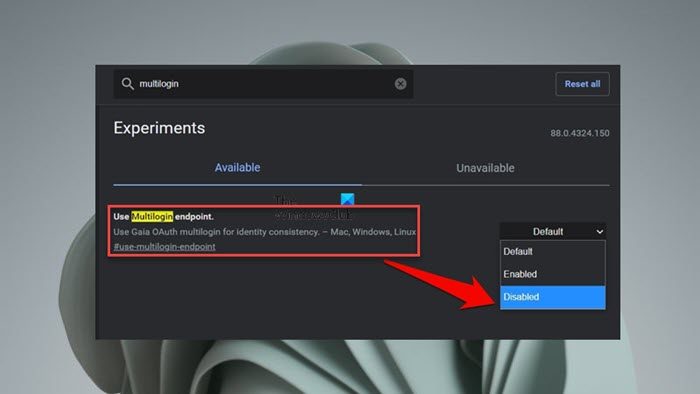
The Multilogin endpoint is the changed Identity Consistency setting in newer Chrome versions that manages the synced accounts on your various devices. However, it seems to be that for some users the setting is not quite replicating across various signed-in devices. In this case, you should consider disabling this feature and see if that solves the problem at hand.
To disable the Use Multilogin endpoint flag, do the following:
- Launch Chrome.
- Type in chrome://flags in its address bar and hit Enter.
- Now, search for the Use Multilogin endpoint flag and change its state from Default to Disabled.
If you are using Chrome build 73.0.3683.103 or earlier, then the above flag wouldn’t be present. Instead, you will have to search for and disable both the Identity consistency between the browser and the Cookie jar flag.
- Once done, relaunch the browser on the prompt.
When Chrome restarts, verify if the issue has been resolved or not. If the issue is resolved but you experience performance and stability issues with the browser, then you might want to revert the Chrome flag to its default state and try out the other fixes mentioned in this post.
3] Turn OFF Clear cookies and site data when you quit Chrome
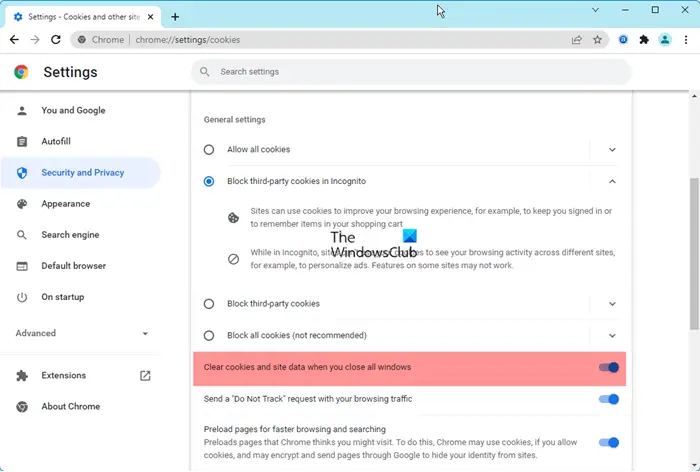
If you notice Chrome sync turns off and is paused every time you close the browser, then you need to check and make sure the Clear cookies and site data when you quit Chrome option is not set to On. To change this setting, follow these steps:
- On your computer, open Chrome.
- At the top right, click More
Settings.
- Click Privacy and Security
Cookies and other site data.
- Turn off Clear cookies and site data when you quit Chrome.
In addition, make sure to add your Google account under sites that can always use cookies by following these steps:
- Open the Google Chrome browser.
- Tap on the three-dot menu in the upper right corner.
- Select Settings from the menu.
- Under Privacy and security, click Site Settings.
- Next, scroll down and click on Cookies and site data under the Content menu.
- In the menu, scroll down to Sites that can always use cookies. and click on the Add button beside the option.
- Now, in the Add a site dialog, enter accounts.google.com in the Site field.
- Click the Add button.
- Restart Google Chrome.
Read: Google Chrome won’t clear Browsing History and Data
4] Clear cache/cookies and Disable extensions in Chrome
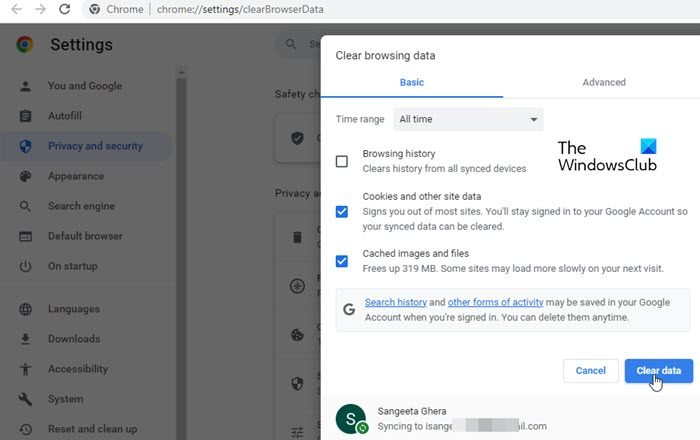
The sync issues you are currently experiencing in the Chrome browser could be due to a corrupted cache or overburdened browsing data. In this case, you can clear the cache and cookies on Google Chrome, then relaunch the browser and see if the issue is resolved.
The browser extensions (especially if out of date or have developed incompatibilities with the latest Chrome builds) are another avenue to explore to determine the culprit of your issue. If you have dozens of Chrome extensions installed, it can be difficult to pinpoint which one of the add-ons is causing the syncing issue. So, the easiest way to go about this task is to disable all extensions and then enable them one after the other in between checking if the syncing is paused. Once you determine the culprit, you can update the extension and see if that fixes the problem, otherwise, leave the extension disabled.
5] Turn on Web & App Activity for your Google account
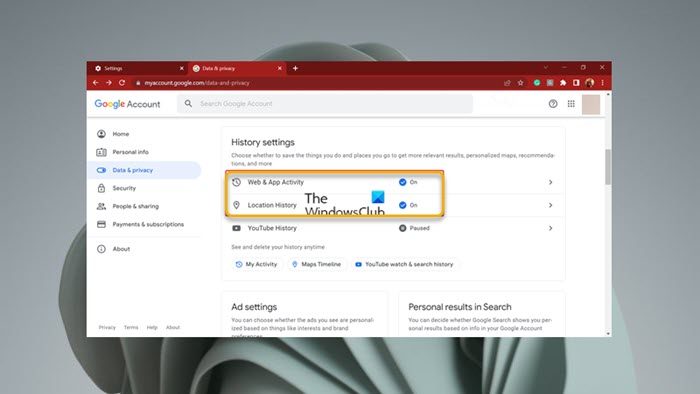
Web & App Activity saves your activity on Google sites and apps, including associated info like location, to give you faster searches, better recommendations, and more personalized experiences in Maps, Search, and other Google services. One of the subsetting includes Chrome history and activity from sites, apps, and devices that use Google services.
This solution requires you to turn on Web & App Activity for your Google account by following these steps:
- Open Chrome.
- Click on the ellipsis near the top-right and select Settings from the menu.
- Click Manage your Google Account.
- Next, click Manage your data & privacy under Privacy & personalization.
- Now, if Web & App Activity is showing Paused, click on the setting to modify.
- Click on the Turn on button.
- Repeat for Location History if the setting is showing Paused.
- Restart Chrome when done.
If the issue persists, continue with the next suggested fix.
6] Modify the Windows registry
The registry key SyncDisabled with a value of 1 will disable data synchronization for your profile in Google Chrome. This solution requires you to set this registry key value to 0 to make sure sync is enabled for the browser on your Windows 11/10 computer.
Since this is a registry operation, it is recommended that you back up the registry or create a system restore point as necessary precautionary measures. Once done, you can proceed as follows:
- Press the Windows key + R to invoke the Run dialog.
- In the Run dialog box, type regedit and hit Enter to open Registry Editor.
- Navigate or jump to the registry key path below:
HKEY_LOCAL_MACHINE\SOFTWARE\Policies\Google\Chrome
- At the location, on the right pane, double-click the SyncDisabled entry to edit its properties.
If the key is not present, right-click on the blank space on the right pane and then select New > DWORD (32-bit) Value to create the registry key, and then rename the key accordingly and hit Enter.
- Double-click on the new entry to edit its properties.
- Input 0 in the Value data field.
- Click OK or hit Enter to save the change.
- Exit Registry Editor.
- Restart your PC.
On boot, launch Chrome and check if the issue is resolved. If not continue with the next solution. Alternatively, you can create and use a REG file to enable the registry key using the code below:
Windows Registry Editor Version 5.00 [HKEY_LOCAL_MACHINE\SOFTWARE\Policies\Google\Chrome] "SyncDisabled"=dword:00000000
Simply copy and paste the code into Notepad, then save the file with a .reg extension, then run the file to merge it to the registry.
7] Reset the Chrome browser to default settings
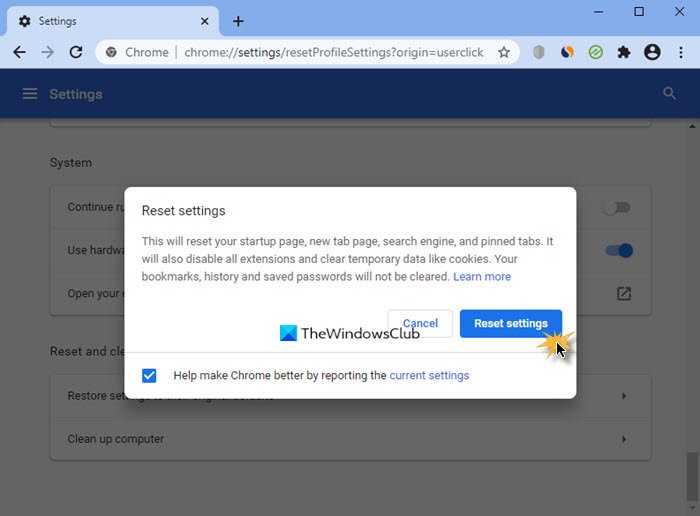
Sometimes it could be that when the wrong browser settings have been applied, it can eventually cause syncing issues with Chrome, especially in the cases where you have enabled beta features. So, as a viable solution to the issue in view, you can reset Chrome to default settings and see if that helps.
8] Use another browser
On the unlikely event that you have exhausted all possible troubleshooting steps, but nothing worked to resolve the issue you’re currently facing, although you might not find it ideal based on your browser preference, you may consider temporarily using (on the off chance that a bug is a culprit which will likely be patched in the next browser update) another Chromium-based browser. You need to export/import your current Chrome browser data.
Hopefully, this post helps!
Read: Fix Google Chrome sync not working in Windows.
How long does it take for Chrome to sync?
The duration of the Chrome browser sync process depends on data size across the accounts. Usually, it takes no longer than 5 minutes. The initial sync may take up to 24 hours (although in some cases maybe 1-2 hours or even faster). Google Sync frequency is usually once every 24 hours – by default, your Android device’s calendar will sync through Google Calendar and be limited to syncing once every 24 hours.
Read next: Fix Microsoft Edge sync issues on Windows.